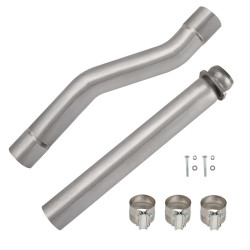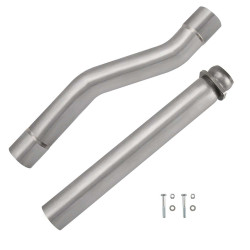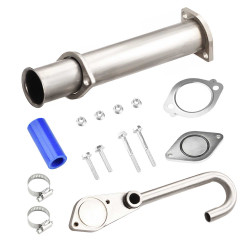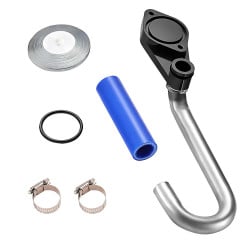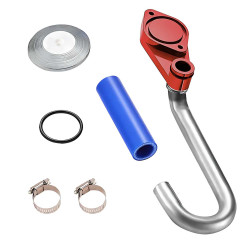Introduction to the 6.0L Powerstroke Engine (2003–2007)
The 6.0L Powerstroke diesel engine, introduced by Ford for its Super Duty lineup (F-250/F-350) starting in 2003, was a major step forward from the 7.3L Powerstroke. Designed by International (Navistar), the 6.0L featured several innovations, including a variable geometry turbocharger (VGT), a high-pressure common-rail injection system, and most notably, an Exhaust Gas Recirculation (EGR) system.
This generation of Powerstroke was the first in Ford’s diesel truck lineup to implement EGR technology. The 2003 model year marked a transition, while from 2004 onward, the EGR system became federally mandated to help light-duty diesel trucks meet stricter EPA emissions regulations targeting NOx reduction.
From the factory, the exhaust flow path for 2003–2007 6.0L Powerstroke trucks typically includes a downpipe, catalytic converter (CAT), muffler, over-axle pipe, and tailpipe. Combined with the EGR system, this emissions package aimed to reduce environmental impact—but it also introduced a host of reliability concerns over time.
With these trucks now nearing or exceeding 20 years of age, many are still in use but are plagued by failures related to their original emissions systems. That’s where delete kits come in.
Common Issues with the 6.0L Powerstroke Emissions Systems
EGR System Failures
EGR-related problems are the most frequent and notorious among 6.0L Powerstroke owners. The EGR valve and cooler are prone to clogging, leaking, or cracking due to carbon buildup and overheating. These failures can lead to performance loss, engine overheating, or even head gasket failure. Deleting the EGR system significantly reduces the overall thermal stress on the engine and eliminates a major point of failure.
Turbo Vane Sticking
Carbon buildup from the EGR system doesn’t just stay in the intake—it also affects the turbocharger. The VGT turbo's vanes are sensitive to soot and debris, often leading to vane sticking, boost lag, or turbo failure. Removing the EGR system greatly decreases the soot load entering the intake side, reducing the likelihood of turbo issues.
Oil Cooler Clogging
The factory oil cooler is another high-failure component. It can become clogged with sediment, especially when combined with coolant contamination or EGR-related heat stress. When the oil cooler clogs, it often causes the EGR cooler to overheat and rupture. Deleting the EGR reduces this stress, and many owners opt to replace the stock cooler with an upgraded or external unit.
Catalytic Converter (CAT) Blockage
While less failure-prone than the EGR system, the catalytic converter (CAT) can become a bottleneck over time—especially after 100,000 miles or more. Trucks running poor-quality fuel or suffering from excessive soot production due to EGR issues may experience CAT clogging. Symptoms include increased exhaust backpressure, reduced power, and higher fuel consumption. On California or other emissions-compliant models equipped with post-CAT oxygen sensors, CAT aging may also trigger diagnostic trouble codes such as P0420. Federal (49-state) versions often lack these sensors, so the issue may go undetected without performance symptoms.
EngineGo Delete Kits: Products and Benefits for the 6.0L Powerstroke
At EngineGo, we offer a range of high-quality delete kits tailored specifically for the 2003–2007 6.0L Powerstroke.
CAT and Muffler Delete Pipes
Our delete pipe kits allow for the removal of the factory CAT and muffler. These delete pipes improve exhaust flow, reduce backpressure, and are ideal for off-road applications including towing, high-speed driving, and performance upgrades. Removing the CAT also helps avoid repair costs related to clogged or deteriorating converters.
EGR Valve & Cooler Delete Kits
Our EGR delete kits are engineered to fully remove both the EGR valve and cooler from your system. This not only eliminates the direct risks of EGR failure but also prevents downstream issues like turbo vane sticking and oil cooler overheating. With fewer emissions-related components, your engine runs cooler, cleaner, and more reliably.
